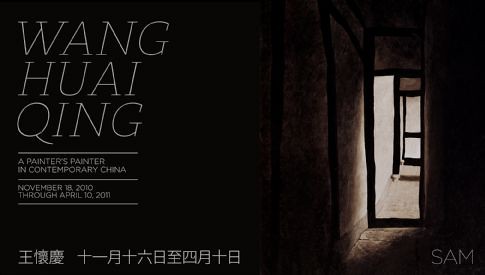
You could call him an éminence grise if his hair wasn’t so white, but he’s not that well known in the U.S., as evidenced by this inaugural-yet-retrospective exhibition. Wang Huaiqing was born in Beijing in 1944, and thanks to his artistic talent was enjoying government-sponsored art education by the age of 12. Later, he studied folk art, architecture, and Western painting, and earned his Master’s Degree with his painting “Wind with Aroma.”
Now in his mid-60s, Huaiqing is an established master. In the 1990s, if you were in the right place at the right time, you could pick up a Huaiqing for between $3,000 and $10,000. Today, his paintings can sell for over a million dollars.
So while his Seattle Asian Art Museum exhibit is called Wang Huaiqing: A Painter’s Painter in Contemporary China (through April 10, 2011), that’s more a reference to his artistic focus than his artworks’ general appeal. You can view 25 of the 26 pieces at SAAM; a large scale piece is being shown downtown at SAM. (I’m told the lack of larger pieces is due to the artist’s residence not being very large, so no canvases more than about six feet would fit.) That may account over one-quarter of his life’s work.
What people tend to see in Huaiqing’s work, at first, is what’s not there: Much of the recent art from China has been in understandably belated public dialogue with the Cultural Revolution and Chairman Mao. But Wang Huaiqing’s foremost association is with a now-disbanded group of artists called “The Contemporaries,” whose manifesto called for, in the classical Confucian mode, “brushing away the ugliness, perversity, and deception, and preserving beauty, warmth, and candor.”
Seattle Met‘s Culture Fiend says:
Wang’s paintings are certainly abstract. They’re almost entirely monochromatic, with the occasional explosion of red—the only reference to Mao’s regime. With the exception of his early sketches, he avoids using people as subjects. Instead, furniture dominates: broken chairs and tables, cloaked in dark shadows, litter his paintings. Dark columns rise from clay pots and light shines through narrow doorways.
Of course, it can nonetheless be interpreted as a political act to look beyond politics, to art. “During the Cultural Revolution he endured the hardship of labor camps and painted secretly in the dark of night,” writes SAM’s Josh Yiu. We’re left to enjoy the “beauty, warmth, and candor.”



Looking forward to enjoying this exhibit. Thank you for this thoughtful background piece. I always enjoy the art, culture and fashion bits brought to this space by the many contributors and know that many things I’ve really valued would have been missed otherwise.